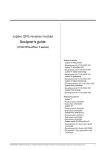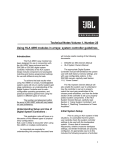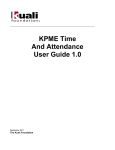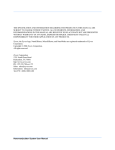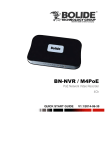Download GPS Chapter
Transcript
GPS Investigation A GLOBE® Learning Investigation GLOBE® 2005 1 GPS GPS Investigation at a Glance Protocol Onetime Only Measurements: Time of initial recording and averaged latitude, longitude, and elevation for the following Study Sites: Atmosphere, Hydrology, Land Cover, Soil Characterization, Soil Moisture, and your school which is the center of your GLOBE Study Site. Suggested Sequence of GPS Investigation • Read the Protocol to learn precisely what is measured and how. • Copy and distribute the Field Guides to your students. • Prior to using the GPS receiver, identify all of your GLOBE sites that require latitude, longitude, and elevation measurements. • Have the students conduct some test measurements near your school, following the GPS Field Guide found in the Protocol section. When you and your students are comfortable with the operation of the receiver go to your GLOBE study sites and, following the GPS Field Guide, take the position measurements at each site. Report your results back to GLOBE as soon as possible upon completing the measurements and calculations. • If one or more of your sites are obscured by tree canopy, follow the Offset GPS Activity Field Guide to determine your site’s position. • If your students are experiencing difficulties with performing the measurements or are interested in further activities related to global positioning systems, refer to and conduct one or more of accompanying activities (Relative and Absolute Directions and What is the Right Answer?) GLOBE® 2005 Welcome - 2 GPS Table of Contents Introduction Overview.......................................................................... Introduction 1 Satellites ........................................................................... Introduction 1 GPS Satellites ................................................................... Introduction 1 Protocols GPS Measurement Protocol GPS Protocol Field Guide Offset GPS Protocol Field Guide Learning Activities What is the Right Answer?* Relative and Absolute Directions Appendix Site Location Data Sheet ...................................................... Appendix 2 GPS Investigation Data Sheet .............................................. Appendix 3 Offset GPS Measurements Data Sheet ................................ Appendix 4 Glossary ............................................................................... Appendix 5 * See the full e-guide version of the Teacher’s Guide available on the GLOBE Web site and CD-ROM. GLOBE® 2005 Welcome - 3 GPS G PS Introduction Our moon is 384,500 km from Earth, and it takes about one month to complete one orbit. Because of fuel limitations or a desire to perform close observations, space shuttles GLOBE® 2005 Introduction - 1 GPS Appendix An object in orbit around a larger body is called a satellite. When the Galileo spacecraft reached Jupiter and slowed down to enter into an orbit around the planet, it became a satellite of Jupiter. When we launch a satellite into orbit around Earth, it becomes an artificial satellite of Earth just as the moon is a natural satellite of Earth. These artificial satellites in Earth’s orbit perform a variety of tasks including: long-distance telephone, television, and data communication, weather and naturalresource observations, military surveillance, and basic science measurements. The Global Positioning System consists of a series of satellites, ground control stations, and users with GPS receivers. See Figure GPS-I-1. These satellites are unmanned and are launched by expendable rockets that place them into orbit. There are 28 GPS satellites in orbit 20,200 km above Earth’s surface. At this altitude, the satellites take about 12 hours to complete one orbit. The satellites are spaced in their orbits so that at least four are always in view of a terrestrial observer at any point on Earth. A ground-based system of tracking stations monitor the orbits of the satellites to an accuracy of ± 1 m, and encodes the satellite’s location, along with the satellite-generated time signal, into the unique identification code transmitted by each satellite. The satellites transmit encoded signals approximately every 15 seconds. When received by a hand-held GPS unit, the data allow the calculation of the latitude, longitude and elevation (or altitude) of the receiver. The radio signals travel in a straight line from the satellite to the GPS receiver passing through clouds, light tree canopies, glass, and plastic, but not through solid structures such as buildings and mountains. When operating, the GPS unit is able to identify each satellite as they come into view, and evaluate the quality of the incoming signals. Modern GPS Learning Activities Satellites GPS Satellites Protocols Yes, students can use satellite data. Although it was originally designed for military use, GPS is now used primarily in civilian applications. As a part of GLOBE, students will determine the latitude, longitude, and elevation of their school as well as of their GLOBE study sites. This information is critical for making GLOBE data useful for students and scientists around the world. The visualization of student data as GLOBE maps would not be possible if the latitude and longitude of each site where students collect their data were not available. Introduction A Global Positioning System (GPS) receiver is a hand-held device that receives data directly from overhead satellites. Using a GPS receiver, students can determine their location, as measured in latitude and longitude, almost anywhere in the world to an accuracy of ± 10 – 15 meters. If they average several measurements, typically they can determine their location to within ± 10 meters or less. Thus, students can determine the location of their GLOBE sites with sufficient accuracy to identify their individual pixel (30 m X 30 m) in Landsat images. and some observation satellites are only a few hundred kilometers above Earth. These LowEarth-Orbit satellites take a minimum of 90 minutes to complete one orbit. Communications satellites are in orbits 35,792 km above Earth. At this altitude, these satellites take exactly one day to circle Earth. This special orbit is called Geosynchronous Orbit. A satellite in geosynchronous orbit always appears to be at the same place in the sky to a terrestrial observer. Thus, an antenna pointed at a geosynchronous satellite need not move. Compare this to a space shuttle which may pass from horizon to horizon in minutes or our moon which may take a month to move across the sky. Welcome Overview Figure GPS-I-1: A Global Positioning System Satellite units may receive signals from up to 12 satellites at the same time. A minimum of three signals is required to give the latitude and longitude, while reception of a minimum of four signals is necessary to calculate the altitude. Reception of a larger number of signals produces a more accurate result. The capabilities of the GPS system rely critically on the development of extremely accurate atomic clocks. The most accurate clocks are capable of neither losing nor gaining more than 1 second in 20 million years! The time given in the GPS receiver is accurate to within one billionth of a second! The combination of clocks in the GPS receiver and atomic clocks on each satellite allow the GPS receiver to record the transit time of each radio signal to within 1 nanosecond (one billionth of a second). Knowing the speed of light (about 1 foot per nanosecond) it is possible to use the time delay, between the transmission and reception of the radio signal, to calculate with extreme accuracy the instantaneous distance from each satellite to the GPS receiver. Converting the simultaneous time delay of signals from three or more satellites into distances, it is possible to calculate, by triangulation, the position (latitude, longitude, and elevation) of the receiver anywhere on the surface of Earth. GLOBE® 2005 Introduction - 2 GPS s l o c o t o r P Students should learn the basics of GPS. Practice making GPS measurements near the school. Make the GPS measurements at the sites specified. Submit your GPS data to GLOBE. GLOBE® 2005 Protocols - 1 GPS Purpose Time To determine the latitude, longitude, and elevation of your school and of all your GLOBE sites 15 minutes to 60 minutes per site Welcome GPS Measurement Protocol Level All The GPS receiver will be used to determine the latitude, longitude and elevation of your school or of your GLOBE sites. Student Outcomes Frequency Once per site Materials and Tools GPS receiver Magnetic compass Tape measure Pencil or pen GPS Protocol Data Sheet Offset GPS Work Sheet Preparation Determine locations to be visited. Bring GPS unit, data sheets, and pen or pencil to field sites. Identify sites where GPS location measurement is not possible because the signal is blocked. For there sites, compass, measuring tape, and Offset GPS Data Work Sheet should be also brought. Learning Activities Prerequisites None Protocols - 1 Appendix Scientific Inquiry Abilities Using a GPS receiver to determine latitude and longitude Using a compass to determine true north and south Identify answerable questions. Design and conduct scientific investigations. Use appropriate mathematics to analyze data. GLOBE® 2005 Protocols Science Concepts Earth and Space Sciences Earth materials have different physical properties (magnetism). Physical Science Position of an object can be described by locating it relative to another object. Materials have measurable properties (magnetism). Magnets attract and repel each other. Geography Tools and technologies have distinct characteristics and capabilities. Use appropriate geographic tools. Latitude and longitude may be displayed on maps. Introduction Overview GPS GPS Protocol – Introduction Have you ever considered how you describe your location, or how to give directions to a place? When you tell a friend where to meet, you will most likely give the location relative to a place or object you’re both familiar with. For example “let’s meet outside the main entrance of our school”. In this case you will both go to the same location because you know the local environment of your school – it is a system that is referenced to your own experience. However, should you plan to meet in a new location unfamiliar to both of you, such as a nearby city, you will need to find a more general framework of reference. For example you could use road systems or topographic references such as rivers or hills. If you want to locate all GLOBE schools and their study sites, you would have to resort to a more universal reference system. The geographic locating system used is a set of lines called latitude and longitude that are mapped, like a grid, onto the spherical surface of the Earth. By convention, zero degrees longitude passes through Greenwich England and zero degrees latitude is the Equator. Locations are identified as being east Figure GPS-P-1: Diagram of one example of a GPS Receiver and west of zero longitude and north and south of zero latitude. At any location it is also possible to further specify ones position by measuring the elevation, or height of the location above or below the average sea level. By reporting their latitude, longitude and elevation each GLOBE school may be individually located. For you, the GLOBE student, the hand-held GPS receiver provides a simple and accurate way to measure your latitude, longitude and, when corrected, elevation. These instruments are sufficiently accurate to distinguish the two ends of a classroom or to determine your location well within an area the size of a single pixel (30 m X 30 m) of a LandSat image. Besides the location, GPS instruments also provide the time, as well as additional measurements such as the speed of travel between two points, and distance and direction between any two locations. Insights into the GPS system as a whole, provide an understanding of the measurements it produces and how a simple measurement relies on a sophisticated science and technology infrastructure. Offset What if you cannot make a GPS latitude and longitude measurement at a study or sample site because the GPS satellite signals are obscured by thick foliage or a building? See Figure GPS-P-2. You can move from your site to a nearby location where the GPS receiver can receive the satellite signals. This is known as an offset location. You can then determine the location of your desired site by measuring the compass direction and distance between the offset location and your site. In general, you need to use trigonometric skills to determine the desired location. However, if you restrict yourselves to moving directly North or South from your site, you can determine the latitude and longitude of your site using only arithmetic and some knowledge about our planet. Our planet is almost a sphere. By dividing Earth’s circumference of 39,941 kilometers by 360 degrees, we learn that there are 110.95 kilometers (or 110,950 meters) in a degree of circumference. By dividing this by 10,000 we GLOBE® 2005 Protocols - 2 GPS Welcome elevation of your location measured with a GPS receiver may be significantly different from the elevation determined by other methods (for example, topographic maps). The GLOBE server will automatically make the geoid correction to your elevation once you have entered your GPS measurements for latitude, longitude, and elevation for your site. Magnetic Variation Elevation Figure GPS-P-3: Geoid and Ellipsoid Surfaces GLOBE® 2005 Protocols - 3 GPS Measures Elevation in Reference to the Ellipsoid. Topographic Elevation is Measured in Reference to the Geoid. Earth’s Surface Geoid Ellipsoid GPS Appendix GPS receivers must also use a reference for determining elevation. Unfortunately, the geoid is very complicated and too large to fit in the internal memory of most GPS receivers. Instead, they contain a simplified shape for a smooth surface known as the reference ellipsoid. All GPS elevation measurements are made against the reference ellipsoid. See Figure GPS-P-3. While the geoid and reference ellipsoid may overlap in some areas, in others they may differ by more than 100 meters. Because of this, the Learning Activities All measurements of elevation are made using mean sea level as a point of reference. For example, Mount Everest has an elevation of 8,850 meters above mean sea level. Since sea level fluctuates daily with tides, the mean sea level surface is used as the reference. The reference surface that passes through the global mean sea level and is shaped by Earth’s gravitational field is known as the geoid. This surface is not smooth because of the irregular distribution of Earth’s gravity field. Protocols learn how many kilometers or meters are in one ten thousandth of a degree of circumference (0.0111 km/0.0001 degrees or approximately 11 meters/0.0001 degrees). GPS receivers typically present locations to the nearest 0.0001 degrees, which is approximately 11 meters of latitude on Earth. Knowing the distance north or south between your site and an offset location allows you to determine the difference in their latitudes. Introduction Figure GPS-P-2: Clear and Blocked Views to a GPS Satellite On Earth, the magnetic North and South poles do not line up exactly with the true North and South poles (along our planet’s rotation axis). Earth’s magnetic north pole is slowly moving and is currently located in Canada’s Northwest Territories about 11 degrees from the North Pole. Additionally, the magnetic properties of Earth’s composition vary slightly among locations. As a result, there is a unique distortion to Earth’s magnetic field at any given place. Typically a small variation of a few degrees must be added or subtracted from magnetic compass bearings to determine the direction of true North. This variation is known as magnetic variation or magnetic declination and its value depends on your location. Figure GPS-P-4 is a world map of magnetic declination. Use this figure to determine true north at your location. You may also use a topographic map to determine the magnetic variation and true North at your location. You will need to use the true North heading for the Measuring Wind Direction Field Guide in the Atmosphere Investigation and for the Offset GPS Field Guide in this Investigation. Be sure to adjust your compass to true North according to the following directions. GLOBE® 2005 Protocols - 4 GPS GLOBE® 2005 Protocols - 5 GPS Figure GPS-P-4 Credit: U.S. Geological Survey USGS/Ft. Collins, CO, USA How to determine the direction of true North at your location: Determine the magnetic declination at your location using the map above. Add this value to zero degrees (magnetic North). The result represents the direction to true North at your location. Note: Please remember that if your declination value is negative, you must subtract this from zero degrees. World Magnetic Declination Map GLOBE® 2005 Protocols - 6 GPS The magnetic needle in a compass is attracted by the magnetism of the Earth, and that is why it always points North. However, there are really two North Poles on the Earth. One is the True North Pole which is located geographically at the top of the earth (at 90o North latitude); and the other is the Magnetic North Pole, an area of highly magnetic rock under central Canada. Because compasses are attracted to metal objects they will give incorrect readings if the user is close to, or wearing, metal objects including watches, keys, etc. Setting Compass Bearings Step 1: Set the dial (B) to the desired degree reading (the direction in which you want to travel) so that the correct compass bearing lines up with the sighting arrow (C). Be sure to choose an object ahead of you in line with your compass bearing and walk toward it. This allows you to walk without looking down at your compass. Every few paces stop and check that you are still traveling in the desired compass direction. GLOBE® 2005 C. Sighting Arrow N E. Orienting Arrow A. Magnetic Needle W D. Base Plate Protocols - 7 E B. Graduated Dial S GPS Appendix Step 3: Your direction or objective will now lie straight ahead in the direction you are holding the compass (the direction in which the sighting arrow points). Figure GPS-P-5: Compass Example Learning Activities Step 2: While holding the compass level, turn your body until the red end of the magnetic needle (A) lines up with the red orienting arrow (E). “Put the red in the shed” is a useful saying to help students remember what to do. The red orienting arrow is considered the “shed.” Protocols Three Basic Parts of the Compass 1. The magnetic needle (See A in the Figure GPS-P-5) is attracted by the magnetic North Pole of the earth. The magnetic end (red) always points to magnetic north. 2. The graduated dial (B) is used to set the desired bearing. The bearing is read in degrees at the sighting arrow (C) at the top of the compass. The dial is graduated in 2 degree increments from 0 to 360 degrees. The cardinal directions are at 0 (or 360), 90 degrees, 180 degrees and 270 degrees which correspond to North, East, South and West. 3. The base plate (D) has an orienting arrow (E) and a sighting arrow (C). Some models also have mirror sights attached. These components are used to line up the magnetic needle and point out the “line of travel”. Introduction Maps and directions are based on True North while the compass needle points to Magnetic North. Magnetic declination is the angle between True North and Magnetic North. Its size and direction depends on where you are on the Earth. It is necessary to determine the declination to take accurate compass bearings. Compasses either have a mechanism to set the angle of declination or a scale to determine declination. Welcome Compass: True North Teacher Support reception due to heavy canopy cover. The school location is to be determined at the front or main entrance to the school, thus building may block satellite reception to some extent. In these cases use the Offset GPS Protocol Field Guide. Measurement Logistics 1. Students must determine the latitude, longitude, and elevation of their school, and for all other GLOBE study sites. 2. Remember, the location and elevation of each site must be determined only once. 3. If you or your school do not own a GPS receiver and you are borrowing one, you may want to determine all the sites for which you need to take GPS measurements. This would allow you to collect GPS data for all the sites in a short period of time (e.g., a week). 4. Locations of GPS measurements: Some GLOBE study sites should provide clear views of the sky and thus good satellite reception (e.g., Atmosphere study site). Others, especially the Land Cover and Phenology sites, may offer poor GPS Student Preparation The Learning Activities in this Investigation provide additional exercises to help students understand the measurements of time, relative and absolute position, and angles, all the basic elements incorporated in the GPS measurement. Helpful Hints Before you use a GPS to receiver make sure that it is set to display the following units: • Time as Universal Time (UT) • Elevation in meters • Latitude and longitude in decimal degrees If it does not, follow the manufacturer’s directions or user’s manual to make these adjustments. Please note that some GPS receivers are not able to display latitude and longitude readings in decimal degrees. If you are using one of these receivers, you should set it to read in degrees and decimal minutes and then convert the latitude and longitude readings to decimal degrees before reporting them to GLOBE. To do so, use the formula and follow the example given below: Converting from Degrees and Decimal Minutes to Decimal Degrees: 1 degree = 60 minutes Reading in decimal degrees = degrees + decimal minutes/(60 minutes/degree) Example: A latitude reading is given as 15 degrees and 39.03 minutes N. Latitude in decimal degrees = 15 degrees + 39.03 minutes/(60 minutes/degree) = 15 degrees + 0.6505 degrees = 15.6505 degrees Site GPS Measurement Location School Main entrance Atmosphere study site Instrument shelter location Hydrology study site Surface water sampling location Soil study sites: Soil Characterization site Soil Moisture site Soil Temperature Soil profile location Center of the soil moisture star pattern Soil Moisture or Atmosphere site locations Land Cover sample sites Center of 90 m x 90 m homogeneous area Phenology Location of the tree, shrub, or one meter square grass area used for the Green-Up and Green-Down measurements. GLOBE® 2005 Protocols - 8 GPS GPS Protocol Field Guide Task Measure the latitude, longitude, and elevation of your school or a GLOBE study site. What You Need ❑ GPS receiver ❑ GPS Data Sheet ❑ Watch ❑ Pen or pencil In the Field 1. Take the GPS receiver to the exact location you would like to determine latitude, longitude, and elevation. 2. Turn on the receiver, making sure that you are holding it vertical and you are not blocking the antenna’s view of the sky. In most receivers the antenna is internal and is located at the top of the receiver. 3. After an introduction message, the receiver will start to search for satellites. Some receivers may display the previous latitude, longitude, and elevation values while it is locking onto satellite signals. 4. Wait for the receiver to indicate that at least four satellites have been acquired and that a good measurement is available. In most receivers, this is indicated by the appearance of a “3-D” message. 5. At one minute intervals and without moving the receiver more than one meter, make five recordings on a copy of the GPS Investigation Data Sheet of all digits and symbols for the following displayed values: a. Latitude b. Longitude c. Elevation d. Time e. Number of satellites f. “2-D’ or “3-D” status icons 6. Turn off the receiver. 7. Average all five latitudes, longitudes, and elevations. 8. Confirm for yourself that your results make sense. You should be able to get a rough estimate of your latitude and longitude by looking at a globe or local map. 9. Copy and submit all GPS readings as your site location to the GLOBE Student Data Archive. 10. Follow this protocol at each site that you need to determine latitude, longitude, and elevation. GLOBE® 2005 Protocols - 9 GPS Offset GPS Protocol Field Guide Task Measure the latitude and longitude of your school or a GLOBE study site when a GPS receiver is unable to make an accurate measurement. What You Need ❑ GPS receiver ❑ Watch ❑ Magnetic compass ❑ Pencil or pen ❑ Tape measure ❑ Offset GPS Measurements Data Sheet In the Field 1. Determine the direction of true North at your location using Figure GPS-P-4. 2. Go to your desired site and mark it with a flag or other obvious marker. 3. Follow the GPS Field Guide to confirm that good GPS reception is not possible. 4. Use the compass to determine true North. 5. Move either North or South to reach the nearest open area in which you can successfully follow the GPS Field Guide. This is your offset location. 6. Follow the GPS Field Guide and record your latitude and longitude. Mark this as the offset location. 7. Record whether the offset location is North or South of your site. 8. Measure the distance between the offset location and your site in meters and record it on the Offset GPS Data Work Sheet. 9. Divide this distance by 110,000 meters per degree to determine the latitude difference (in ten thousandths of a degree) between the offset location and your site. 10. Depending on the direction of your offset location: • If you moved to the north of your site, subtract this value from the latitude of the offset location to determine the latitude of your site. • If moved to the south of your site, add this value to the latitude of the offset location to determine the latitude of your site. 11. The longitude of your site is the same as that of the offset location. 12. Determine the elevation of your site by using a topographic map. GLOBE® 2005 Protocols - 10 GPS 1. How long does it take for a GPS receiver to determine latitude, longitude, and elevation? 2. The receiver is not displaying latitude or longitude. Why? Protocols The receiver has many functions available on various display screens besides the “Location “ screen that usually appears first when the unit is powered up. Please read the manual and familiarize yourself with these other functions of your GPS receiver. Do not record data if any such messages appear. When the receiver has a good view of the sky, waiting or moving slightly will usually cause these messages to disappear. Standing close to the receiver or a group of people hovering around the receiver may block the receiver’s view to the satellites and may cause intermittent signal losses which will prompt the messages to appear. Stand back or hold the receiver high. In thick foliage or heavy canopy, the receiver may be unable to lock to the requisite four satellites. Because the satellites move in the sky, trying again at a later time may provide better results. If problems persist due to obstructions, follow the Offset GPS Field Guide. Introduction The GPS receiver may require anywhere from several seconds to several minutes to acquire a sufficient number of satellites after it has been activated. This depends on the availability of GPS satellites overhead at the time of your measurement, on the presence of obstructions, and on the energy level of your receiver’s batteries. If it takes more than five minutes to get a satellite lock, change your batteries and try again. 3. The receiver displays “Insufficient Satellites”, “ Poor Signal Reception”, or similar message. What should we do? Welcome Frequently Asked Questions Learning Activities Appendix GLOBE® 2005 Protocols - 11 GPS g n i n r a e L vities i t c A ? ! What is the Right Answer?* Through a series of activities, students will learn that there are no “right” answers to some questions. A GPS receiver is optional. Relative and Absolute Directions A set of activities to introduce students to latitude, longitude, coordinates and relative and absolute directions. A GPS receiver is not needed. * See the full e-guide version of the Teacher’s Guide available on the GLOBE Web site and CD-ROM. GLOBE® 2005 Learning Activities - 1 GPS What is the Right Answer? ? Time To introduce students to the concept that sometimes there is no one “right” answer to a question or measurement Approximately one class period Welcome Purpose Level Student Outcomes Learn how to measure time. Understand the accuracy of a measurement. At least one clock per student, any type, which shows seconds, will suffice Paper and a writing tool for each student to record times Copies of the GPS Investigation Time Measurements Work Sheet and plot forms for each student Optional but desirable: Calculator with addition, subtraction, multiplication and division functions GPS receiver (Used as a source of standard time. Access to a GPS receiver is not essential. If available, use it as a highly accurate clock.) Preparation Provide at least 10 clocks for use by the class. The students can use school clocks or bring in clocks from home. Prerequisites Beginning levels - ability to read time on a clock Intermediate and advanced levels plotting and graphing skills What is the Right Answer? Learning Activity - 1 Appendix Science Inquiry Abilities Identify answerable questions. Design and conduct scientific investigations. Use appropriate mathematics to analyze data. Develop descriptions and explanations using evidence. Materials and Tools Learning Activities Science Concepts Levels of measurement incorporate degrees of accuracy. There are mathematical techniques for characterizing the accuracy of a measurement. Middle and Secondary - do the full activity Protocols Students learn to be careful when searching for a “right” answer to questions such as “What time is it?” by comparing multiple measurements of the time-of-day. Students gain an intuitive understanding of the characteristics of imperfect measurements. Using different clocks, students simultaneously record the displayed times. The resulting time measurements are converted from minutes and seconds to seconds. These measurements are plotted to illustrate the mathematical techniques of averages and deviations from an average. Introduction Elementary - do only the clock comparison step Overview GLOBE® 2005 ! GPS Background GPS measurements will be made by a large variety of instruments scattered over large geographic regions and long periods of time. Efforts have been made to recommend instruments of sufficient accuracy and resolution to suit the underlying scientific goals. However, there will be variations between the measurement values because of the diversity of instrument conditions and student researchers. What Is the Right Answer? When people make measurements, they usually wish to know something about the quality of their acquired values. Typically someone asks, “How far am I from the right answer?” or “Did I get the right answer?” This assumes that there is a right answer against which to compare the measured value. because you can read the second hand to about one second. An analog clock with only hour and minute hands has a resolution of only about one minute unless you consistently can determine the location of the minute hand between individual minute markers. However, the clock that can be read to a resolution of 1 second can deviate from some standard time source from a fraction of a second up through a few hours. The ability of a clock to maintain “correct” time is called its accuracy. Therefore, if you have a clock that gains 10 minutes every day, you still may be able to read it to a resolution of a single second, but it is accurate to only 10 minutes per day. Some say that this clock has an error of 10 minutes per day. Sometimes there is a right answer. However, when scientists begin measuring a quantity, especially if it is the for first time, there may not be a standard against which to compare one’s results. If you have the only instrument for making a particular measurement and you have no reason to doubt the values that you are recording, then it is reasonable to consider yourself to be the standard. A problem comes when there exist either multiple measurement instruments or someone claims to be able to produce “the right” or better results. It has been said, “Someone with two watches does not know the time.” In this case, you, the scientist, have to decide how to handle potentially different measurement values or how to choose which measurements and standards to use. Resolution and Accuracy Using Clocks The number of digits or the smallest unit of time that can be read reliably by a person observing a clock is called the instrument’s resolution. Thus a digital clock that displays 12:30:21 (meaning 12 hours, 30 minutes, and 21 seconds) has a resolution of about one second because the clock user can read the clock to the nearest second. An analog clock (which has hour, minute, and second hands) also has a resolution of about one second GLOBE® 2005 Figure GPS-RA-1: A collection of clocks, all with different accuracies and resolutions. Clocks are machines that display a count of something that changes as time passes. Early clocks determined time by counting falling drops of water or grains of sand. These were not particularly accurate because size of water droplets or an amount of sand falling is hard to control. Later clocks counted the swings of pendulums, the vibrations of tuning forks, mechanical oscillations in electrically stimulated crystals, and atomic resonances. Each of these subsequent clocks is more accurate than its predecessor, and all depend on the increased stability and repeatability of an underlying cyclical physical process. See Figure GPS-RA-1. What is the Right Answer? Learning Activity - 2 GPS GLOBE® 2005 Telecommunications Computer communication depends on time measurements that must be substantially more accurate than the rate at which the data flows. If one is using a 14.4k bit/second modem to transfer data via the Internet, a new information bit may be presented to the modem every 1/14,400 seconds or 70 microseconds. Thus, the clocks in the computer hardware must have sufficient resolution to separate each individual 70 microsecond slice of time and must be sufficiently accurate between the transmitting and receiving computers’ clocks so as not to become unsynchronized by more than a fraction of the 70 microseconds. These needs are What is the Right Answer? Learning Activity - 3 GPS Appendix Today all time zones are referenced to a longitude of 0 degrees that goes through Greenwich, England. Greenwich houses one of the great astronomical observatories. It was established for standardization of time for British naval navigation. Thus, the time in Greenwich, England, is used as a standard and is called Greenwich Mean Time (GMT), Universal Time The Global Positioning System has a series of satellites that broadcast timing signals from highlyaccurate onboard atomic clocks. Therefore, a GPS receiver can determine its time to an accuracy comparable to that of the clocks on the satellite. The GPS receiver can even remove the delay due to travel time between the satellite and the terrestrial receiver because the receiver knows both the satellites’ and its own locations. Thus, GPS receivers have become the best alternative to having your own atomic clock. Learning Activities Until the advent of the American railroads in the late 1800s, there were few widely accepted standards for time. Each population center had its own clocks that were usually referred to local solar noon when the sun peaks in the sky or some other celestial event. However, once one moves through 15 degrees of longitude or about 1600 kilometers along the equator, the time of local noon has changed by an hour. To facilitate consistent scheduling across continent-sized areas of our planet, time zones were created and implemented. The railroads needed and presented a common time reference frame. The Global Positioning System Protocols Time Standards The Navy and the National Institute of Standards and Technology (NIST) within the United States and telephone companies maintain standard times using highly accurate atomic clocks that count the vibrations of a variety of atoms under well-defined conditions. The U.S. radio station with the call letters WWV continuously broadcasts the time of day in English on the short-wave radio frequencies of 5, 10, 15, 20, and 25 MHz from Boulder, Colorado. These frequencies themselves are locked to atomic time standards. The Canadian government provides a similar service in both English and French with their short-wave radio station CHU on 7.335 and 14.670 MHz. Many such services exist globally. Introduction In the case of deciding when to feed a pet, an error of a few minutes from day to day may be insignificant. However, a Global Positioning System location measurement depends on the clocks onboard the satellites being highly accurate. An error of a single microsecond (1/1,000,000 second) may cause the displayed GPS location to be in error by more than 300 meters. The desired resolution and accuracy depend on you (the user) and your understanding of your application. (UT), or sometimes Zulu time. (Zulu refers to zero or the 0 degree longitude.) In the GLOBE GPS Protocol you will use the Universal Time (UT) designation for your measurements. Welcome For all clocks to display the same time, ideally each clock would have to be set to the same time simultaneously and experience the same environmental and mechanical conditions. This rarely happens. Clocks typically are set at different times from different references, having different accuracies, with different constructions, and experience different environments. A given collection of clocks will tend to offer a collection of slightly varying time values. This variation in measurement values will be true of most instruments for the temperature, distance, and other measurements of the GLOBE Program (thermometers, tape measures, etc.). met easily by the use of quartz crystals that can be made to vibrate mechanically at chosen values of between 10 thousand and 100 million times per second. The vibrations are electronically counted by a digital circuit to determine the amount of time which has passed. What To Do and How To Do It Step 1. Get the Clocks Locate at least ten (and preferably more) operating clocks that display time to a resolution of one second. Assign a student to each clock, and declare one student to be the master timekeeper. In a classroom situation where many students may have wrist watches with one second resolutions, these clocks will suffice. Wall clocks displaying seconds in a variety of different rooms are also adequate. Each student should be prepared to record a time and be able to see or hear the master timekeeper. Step 2. Take the Measurements Centrally locate the master timekeeper. At 30 minutes and zero seconds after the hour, this student is going to indicate to the other students to record their clocks’ displayed time values to the nearest second. Perhaps ten seconds before the designated time, the master time keeper may begin counting down aloud to prepare the other students. Although any particular time will work, choosing 30 minutes into the hour increases the chances that during the measurements no clocks will advance to the next hour and thus complicate later arithmetic processing. Advanced students: Have the students perform the computations and graphing. Other students: The teacher performs the computations and graphing outside of class for later presentation and discussion. While younger students may not understand the arithmetic, they do understand how the shape of the histogram plot appears for various clock accuracies. GLOBE® 2005 Step 3. What time was it? For details, see the sample GPS Investigation Time Measurements Work Sheet and instructions. Determine the average of all time-of-day measurements. To determine the average time of day when the data were recorded: Determine the number of seconds past the hour for each participant’s recorded time. Add these seconds values to produce a sum. Divide by the number of participants to produce the average time. Convert this back to minutes and seconds and record. Step 4. Are our clocks any good? Determine Deviation from the Average. For each participant, compute the difference of each participant’s time value from the average. Do not keep the sign. All results are positive. Add these together to produce a sum. Divide this sum by the number of participants to produce the average deviation. The average deviation is a measure of how far each measurement is from the average time Plot differences from the average of our recorded times. See Occurrences Versus Differences Work Sheet. Each bin is 10 seconds wide and is 10 seconds from the average number of seconds. Record the average number of seconds in the center box. Place an X in the appropriate bin for each participant’s number of seconds into the hour. This type of plot is called a histogram. How would the plot be different if we had a more or less accurate collection of clocks? What is the Right Answer? Learning Activity - 4 GPS Welcome Further Investigation If you have access to a GPS receiver, use its time to set a clock that can be used as the master clock for the measurements. The GPS receiver’s displayed time will probably be the most accurate time available. If we have higher quality clocks, how will our computed average deviation change? Introduction Students with access to spreadsheet computer programs may wish to automate the arithmetic computations found on the work sheet. Advanced students may wish to investigate the statistical concepts of standard deviation and variance. Student Assessment Protocols Quantitative Ask students how the histogram plot would be different if they had a better or worse collection of clocks. Better: X’s grouped closer together. Worse: further apart. Could they record clock values? Could they understand the arithmetic? Should any of the data be rejected? If a data sample is obviously inappropriate, such as from a stopped clock, yes! Learning Activities Qualitative The student should be able to describe situations in which it is and is not reasonable to demand a “right” answer. The student should be able to list examples of measurements that they make in their lives and should contrast between the available and desirable resolutions and accuracies for these measurements. The student should take responsibility for determining the accuracy and resolution necessary for the measurements required by an investigation. Appendix GLOBE® 2005 What is the Right Answer? Learning Activity - 5 GPS Figure GPS-RA-2: An Example Time Measurements Work Sheet GPS Investigation Time Measurements Work Sheet Your Name: Jordan Malik Participant Number 1 2 3 4 5 6 7 8 9 10 11 12 (Hr 12 12 12 12 12 12 12 12 12 12 Today’s Date: April 14, 2001 Recorded times Min Sec) 30 29 30 30 31 30 30 30 29 30 0 54 1 15 1 25 3 7 22 1 Seconds past the Hour (Seconds) Average (Seconds) 1800 1794 1801 1815 1861 1825 1803 1807 1762 1801 Difference from Average (Seconds) Average of Differences (Seconds) 6.9 12.9 5.9 8.1 54.1 18.1 3.9 0.1 44.9 5.9 16.08 Average Deviation 1806.9 Average Number of Seconds into the Hour Ten Students Participated 13 14 15 16 17 18 19 20 10 Instructions Record Times Difference Sum divided by number of Participants Sum divided by number of Participants = No. of Participants 18069 = Sum 160.8 = Difference Sum Average Time (Seconds) (Minutes) 30 6.9 Computations Determine the number of seconds past the hour for each participant’s recorded time. (Total Seconds = Minutes x 60 + Seconds) Determine the average time. (Average time = Sum of seconds / Number of participants) Compute the difference of each participant’s time value from the average. (Difference = Seconds into the Hour - Average Seconds) (Do not keep the sign – All results are positive numbers) Determine the averages of the differences. Plot Histogram Record the average number of seconds in the center box. Each bin is 10 seconds away from the average and 10 seconds wide. Determine the time for each bin by adding or subtracting from the average. For each number of seconds into the hour, place an “X” in the nearest bin. (The number of X’s should be the same as the number of participants.) GLOBE® 2005 What is the Right Answer? Learning Activity - 6 GPS GPS Investigation Time Measurements Work Sheet Your Name: Jordan Malik Participant Number (Hr Today’s Date: April 14, 2001 Recorded times Min Sec) Seconds into the Hour (Seconds) Average (Seconds) Difference from Average (Seconds) Average of Differences (Seconds) 1 2 3 4 5 6 7 8 9 10 11 Average Number of Seconds into the Hour 12 13 14 Average Deviation 15 16 17 18 19 20 10 Instructions Difference Sum divided by number of Participants Sum divided by number of Participants = No. of Participants = Sum = Difference Sum Average Time (Seconds) (Minutes) Record Times Computations Determine the number of seconds into the hour for each participant’s recorded time. (Total Seconds = Minutes x 60 + Seconds) Determine the average time. (Average time = Sum of seconds / Number of participants) Compute the difference of each participant’s time value from the average. (Difference = Seconds into the Hour - Average Seconds) (Do not keep the sign – All results are positive numbers) Determine the averages of the differences. Plot Histogram Record the average number of seconds in the center box. Each bin is 10 seconds away from the average and 10 seconds wide. Determine the time for each bin by adding or subtracting from the average. For each number of seconds into the hour, place an “X” in the nearest bin. (The number of X’s should be the same as the number of participants.) GLOBE® 2005 What is the Right Answer? Learning Activity - 7 GPS GLOBE® 2005 What is the Right Answer? Learning Activity - 8 GPS Plot 1: Histogram of Number of Occurrences versus Differences Occurrences Versus Differences Work Sheet GPS Investigation Figure GPS-RA-3: An Example Occurrences Versus Differences Work Sheet 2001 GLOBE® 2005 What is the Right Answer? Learning Activity - 9 GPS Plot 1: Histogram of Number of Occurrences versus Differences Occurrences Versus Differences Work Sheet GPS Investigation ? ! Welcome Relative and Absolute Directions Time Learning about latitude and longitude Developing math skills From one to five class periods depending on which steps you choose to do Overview Level Students begin by asking the simple question: “Where Am I?” Then they learn All levels with some exceptions noted about the magnetic Earth and the use of compasses and angles. Students also learn about the difference between relative and absolute locations. Throughout this activity, students practice using a variety of math skills. Student Outcomes Paper and pencil Graph paper Magnetic compasses Drawing compasses (for drawing circles) Globes Metric rulers and meter sticks Bar magnet Preparation None Prerequisites Beginning levels: Students should be at the appropriate developmental level to be able to learn about the use of latitude and longitude to find a location. Intermediate and advanced levels: Basic understanding of degrees, angles and coordinate systems. Learning Activities Science Concepts Latitude and longitude determine location. A compass may be used the Earth’s magnetic field to give direction. Physical Science The position of an object can be described by locating it relative to another object. Geography Location is used to display information on maps. Materials and Tools Relative and Absolute Directions Learning Activity - 1 Appendix Science Inquiry Abilities Use a magnetic compass to accurately determine angular direction. Identify answerable questions. Design and conduct scientific investigations. Develop descriptions and explanations using evidence. Communicate procedures and explanations. GLOBE® 2005 Protocols Learn how to locate a position. Introduction Purpose GPS Background The GLOBE program uses GPS receivers to determine the latitude and longitude of GLOBE study sites. However, the ideas of latitude and longitude, coordinates attached to absolute reference systems, or angles from north may be new to many students. This set of activities introduces these concepts. When you ask students, “Where are you?”, they may respond, “At home” or “At school.” The answers are in their own local reference frame. If you use a magnetic compass to determine the direction to a tree that is north of you, you will probably conclude that the tree is to your north. However, if you move east or west by any substantial amount and use the same compass to determine your direction to the same tree, you will find the tree to be to your northeast or your northwest. Neither the tree nor Earth’s magnetic poles have moved, but your compass indicates a different direction to the tree. There is something absolute about the positions of the tree and the poles, but there is something relative about your measurement technique. The starting point moved. If we impose a gridded coordinate system upon our geographic area of interest or the entire world and number the various lines on the grid, we now have a reference frame in which we can uniquely determine any location independent of the relationship between your location and that of another individual. Latitude and longitude are the names of the values for the coordinate system in which we shall be working for geographic determination of locations with the Global Positioning System. to ask are: How can you describe your location to another student: in your classroom? in another classroom? in another school in town? in another town? in another country? Did students describe their location using relative or absolute references? Emphasize their reference frames. Figure GPS-RE-1: The Earth as a Giant Magnet Step 2. Attempting to Impose a Reference Frame: The Magnetic Earth (For all levels) Our planet projects a gigantic magnetic field as if it contained a large bar magnet. See Figure GPSRE-1. Another magnet (like a magnetized needle) will be attracted to our planet’s magnetic poles. A magnetic compass contains a magnet which can spin freely and be observed. Thus, magnetic compasses are useful navigational instruments because they allow one to see the direction of Earth’s magnetic field, which almost lines up with Earth’s north and south poles. What To Do and How To Do It Step 1. Relative Positions: Where am I? (For all levels) Have students ask themselves the question, “Where am I?” and have them list words or draw a rough picture of where they are. Lead a class discussion on what defines “where are we?” Encourage questions and time for reflection on where a person is and how one might explain where anyone was. Good questions for students GLOBE® 2005 Figure GPS-RE-2: Suspended Bar Magnet Relative and Absolute Directions Learning Activity - 2 GPS Welcome Suspend a bar magnet on a string away from large metal objects and allow the magnet to stop any rotation or spin. Attach the string to the ends of the magnet as shown in Figure GPS-RE-2. To use the compass, hold the compass on your fingers of your outstretched hand and arm. Hold the compass flat relative to the ground so that the needle can move freely, and keep it away from all metal objects. Position yourself so that you can look across the compass through north while waiting for the needle to stop moving. Do not place the compass near the magnet; it will lessen the effectiveness of the compass. Remember that good scientists are specific in their descriptions and their drawings. They compare and contrast in their observations. Examples would include the following descriptions at two different schools. See Figures GPS-RE-3, GPS-RE4a and 4b. 1. The red-brown brick building with the green window frames is due west. To the north of that building is the factory with the tall smoke stack. 2. The area to the east has a single oak tree with a fence extending away from the observer. Ask questions about the observations to encourage students to compare and contrast. Learning Activities • Record your specific location (e.g., on the big rock outside our classroom window) and the date. • List all things that are directly to your north (use the compass to find your direction), east, south, and west, then write a descriptive paragraph on each direction. Tip. Be specific about what is seen and the direction it is from you. Also record only permanent objects. In areas where there are many things that look similar, try to pick out specific differences. Protocols Step 3. Introductory Compass Angles (For beginning levels) On a blank sheet of paper, record the following observations, using a magnetic compass for direction. Figure GPS-RE-3: A panoramic view Introduction Ask students what will happen. The magnet will eventually stop spinning so that its poles are aligned with north and south directions. Students can test the north-south direction by comparing the magnet with a magnetic compass. Appendix Figures GPS-RE-4a and GPS-RE-4b: View from a school site facing west, view from a school site facing east GLOBE® 2005 Relative and Absolute Directions Learning Activity - 3 GPS Step 4. Intermediate and Advanced Compass Angles (For intermediate and advanced levels) You can divide a circle around you into 360 degrees. This is also written as 360˚. See the GPS Learning Activity Working with Angles. Navigational directions from some location are given as angles around such a circle, with north at the starting place, or 0˚. East is 90˚. south is 180˚; and west is 270˚. Angular Directions from North Your hand can be used to measure directional angles effectively. As illustrated in Figure GPS-RE5, if you extend your arm, make a fist, and then extend your thumb, the width of your hand (with thumb extended) is about 15˚ (you may need to extend the little finger as well). That means that six of your hands with extended thumbs would fit between north and east. (Each fist with extended thumb equals 15˚, because there are 90˚ between north and east, and 90˚ divided by six fists is 15˚ for each fist.) Figure GPS-RE-5: Using your hand to measure 15˚ Because the angular relationships of each individual’s hand will differ slightly, you may find Figure GPS-RE-5: Using your hand to measure 15° that you have to extend your finger slightly so that six “fists” fit into 90 degrees. You may need to try to measure six “fists” between north and east several times before you consistently get the same number of “fists” on repeated trials. Hold your hand as steadily as possible. Focus on what is at the tip of your thumb, and then move your hand so that the back of your hand is now where your thumb tip was. Because you always take your hand with you, remember how you extended your arm and hand GLOBE® 2005 so that you can make future angle measurements. Practice positioning your hand and thumb so that you get a consistent number of “hands” between north and east or north and west. Now record what you see at the end of each hand width. After you feel confident with your measurements go on to the panorama observations below. Step 5. Panorama Observations (For all levels) Take a sheet of paper and fold it in half lengthwise. Cut along the fold, so that you have two long halves of the paper. Tape two of the ends together and mark the four directions on the paper, as indicated in Figure GPS-RE-6, so that north is on the two far ends and south is in the middle. Record all observations as drawings on the long narrow strip of paper. Now that you have had experience with the magnetic compass and with the compass directions, position yourself in the same spot as you did for the compass activity. Draw a panoramic view of what the landscape looks like all around you by making multiple individual drawings for each of the four north, south, east, and west directions. Students can mark all the other directions that fall in between (south southeast, northwest by north), by measuring the angles with their fists. Step 6. Telling Time with the Sun To extend this step further, use your fist to measure time. Because the sun moves 15˚ per hour through the sky, one can estimate the time in hours until sunset by measuring the number of hand-widths from the sun to the western horizon. Knowing your local time of sunset, you can then work backward and estimate your local time without a clock! N W S E N Figure GPS-RE-6: Preparing the strip for drawing a panorama Relative and Absolute Directions Learning Activity - 4 GPS Figure GPS-RE-8: Overhead diagram of students facing a particular mark GLOBE® 2005 Relative and Absolute Directions Learning Activity - 5 GPS Appendix Earth’s magnetic poles appear fixed. However, an observer on the equator will claim the direction to the north as being along a line tangent to the equator. Another observer who is half way from the equator to the north pole will also claim that the direction north is a line tangent to the globe at his location. However, these two lines are not parallel. See Figure GPS-RE-9. Therefore, they are not pointing in the same direction. Get a globe and try this for a variety of different locations around the world. You can see that the direction you call north depends on your location. Therefore, north, south, east, and west are relative directions. These directions are angle measurements in the direction of the magnetic north pole relative to the location from which the measurement is taken. Learning Activities Why did each student get a slightly different measurement? Were they all not looking at the same point? Their compass angles are relative to their individual and different locations. Figure GPS-RE-9: The direction North as perceived at different points on Earth Protocols In Figure GPS-RE-8, the boxes represent individual students. With compass in hand, the first student takes a bearing on the mark and finds that the direction is north and the angle is 0˚. The students will then record “0˚” in the box, marked “1.” Have each student, in numerical order, make an angle measurement between north and the mark. Because all results will be between north and east for the scenario illustrated, all measurement results should be between 0˚ (north) and 90˚ (east). Introduction Step 7. Are the North, South, East, and West Directions Relative or Absolute? (For all levels) Go outdoors and mark a point about two meters above the ground (for example, crossed strips of tape on a school window), so that you can have the students stand along an east-west line south of the mark. Have the students form a line with the person on the far east due south of the mark. The students should be spaced at arms’ length. See Figure GPS-RE-7. Welcome Figure GPS-RE-7: Students lined facing a mark to the North Step 8. Compass Directions Are Relative to Your Location (For all levels) For practical purposes, Earth’s north and south magnetic poles are fixed close to our planet’s north and south spin axes. In the absence of other magnets, a magnetic compass needle aligns itself with Earth’s magnetic field. Thus, its needle will point to Earth’s magnetic poles. (The Earth’s magnetic poles will not move much during our lifetimes.) Step 9. Describing a Location (for all levels) We wish to introduce absolute reference frames for describing locations. Students will expand upon past activities to answer the question “Where am I?” or “Where is something?” and will learn that they must specify the “where” with sufficient clarity so they can communicate their position unambiguously to someone else. We ask students to provide directions relative to some agreed-upon reference or some coordinate system instead of relative to themselves. Cartesian coordinates (x,y Figure GPS-RE-10: Directions from home to school are axes in geometry and algebra) and latitude and different for everyone longitude on the globe provide such a system. ANOTHER HOUSE YOUR HOUSE North 0° North 0° East 90° West 270° 180° South East 90° West 270° 180° South ANOTHER SCHOOL YOUR SCHOOL Further background: Directions are not necessarily unique. What problems does this cause? Navigation between arbitrary locations requires a known point as a fixed reference. Giving directions to listeners who are located at different positions means that they must agree to some point in common before directions can be given. Unique starting and ending points (like trade routes), provide an absolute or fixed reference frame such as a coordinate system placed on a map. Latitude and longitude provide a similar reference frame for our spherical planet. Use the drawing and map in Figure GPS-RE-10 to help students understand relative and absolute directions and positions. A full page version of Figure GPS-RE-10 is included at the end of this Learning Activity for you to make duplicates for student use. Describe how to go from your school to your house. Then describe how to go from another school to another house. Then ask, what is the difference? A riddle about absolute directions: Someone builds a house. All of the outside walls of the house face south. A bear walks up to the house. What color is the bear? (Answer: White - if all sides of the house face south, then the house must be at the North Pole. The only bears in the Arctic Circle are polar bears.) GLOBE® 2005 Place two students back to back, each with checker boards, so that each cannot see the other’s board. Give them two checkers (tokens) and have one place the tokens anywhere upon the board. Without imposing further rules, have that student describe to the other student where to place the token, so that each token is in the same position on each board. Repeat the process beginning with the second student. Lead a discussion on the communication between the two students. How did the students choose to communicate the locations of their tokens? What determined the clarity and difficulty of their communications? Figure GPS-RE-11: Describing checker locations Relative and Absolute Directions Learning Activity - 6 GPS Welcome Step 10. Numerically Describing a Location (for intermediate and advanced levels) Label a piece of graph paper or a drawn grid as shown in Figure GPS-RE-12, Have students find positions communicated as follows: (1,2), where the first number describes the distance to move to the right from zero on the horizontal axis and the second number describes the distance to move up along the vertical axis. Discuss what information is needed to communicate points and drawings. For example, each line required information about a starting point and an end point. Protocols Figure GPS-RE-12: Label a sheet of graph paper On a new piece of gridded paper, go to position (7,4), and draw an arc with a drawing compass that has a radius of two units. With position (1,1) as the center, draw an arc with a radius of five units that intersects the first arc. Finally, draw a third arc, with a radius of five units and which has a center at (8.0). Where do they intersect? How many arcs are needed to determine a point. Introduction Figure GPS-RE-14: Cartesian coordinates defining Suppose that the Cartesian coordinates in Table GPS-RE-1 were mapping a portion of ocean and that the side of each square was the distance it Learning Activities Signal travel time Figure GPS-RE-13: The resulting simple Then, have students draw a simple picture from the following lines between the given sets of positions. See Figure GPS-RE-13. (4,1) to (5,2) (5,2) to (5,5) (1,4) to (1,1) (1,1) to (4,1) (1,4) to (4,4) (1,4) to (2,5) (2,5) to (5,5) (4,4) to (5,5) GLOBE® 2005 Location milliseconds Alexandria (0,0) 4.0 Corsica (1,5) 2.0 Hsuchou (6,3) 3.5 Table GPS-RE-1: Ship location and time for Bainbridge’s signal to travel to each ship Relative and Absolute Directions Learning Activity - 7 Appendix (4,1) to (4,4) Ship GPS Table GPS-RE-2: Places on the Globe Latitude Longitude Name 36˚N 139˚E _______________________ 60˚N 30˚W _______________________ 27˚S 109˚W _______________________ 90˚S 0˚E _______________________ 90˚S 180˚W _______________________ __ __ Your location __ __ Your opposite location takes a radio signal to travel in one millisecond. There are three ships at sea, the Alexandria is at (0,0), the Corsica is at (1,5), and the Hsuchou at (6,3). Each ship receives a distress signal from a fourth ship, the Bainbridge. The time that it took the Bainbridge’s distress signal to travel to the three potential rescue ships will help the ships locate Bainbridge’s position. Can you find the distressed ship? (Measurement of signal travel times forms the basis of radar and GPS.) Step 11. Describing Geographical Locations (for intermediate and advanced levels) On a globe, the east-west lines are lines of constant latitude and the north-south lines are lines of constant longitude. Have students discuss how they are similar to and how they are different from the lines they found on the Cartesian coordinate system. Find the locations listed in Table GPSRE-2. Adaptations for Younger and Older Students Qualitative descriptions of measurements may be more appropriate for younger students. For example, describing a compass direction as being “northeast” may be clearer than “45˚ from north.” More quantitative and analytic techniques may be appropriate for older students. For example, they can use the Pythagorean Theorem to determine distances between locations in a flat, gridded coordinate system. Student Assessment Have students identify various cities or geographical features using latitude and longitude. Give them a list of cities and have them determine latitude and longitude for each. Also have them find distances between geographical locations. Take a globe and find your location. Estimate values for your latitude and longitude from the globe. Now find the point on the globe opposite your location and estimate its latitude and longitude. What are the relationships between the latitude and longitude coordinates for these two opposite locations? Note: Steps 9, 10, and 11 present concepts similar to those in Odyssey of the Eyes Learning Activity in the Land Cover/Biology Investigation. GLOBE® 2005 Relative and Absolute Directions Learning Activity - 8 GPS GPS Investigation School Site Location Map Graphic ANOTHER HOUSE YOUR HOUSE North 0° North 0° West 270° East 90° East 90° West 270° 180° South 180° South ANOTHER SCHOOL YOUR SCHOOL GLOBE® 2005 Relative and Absolute Directions Learning Activity - 9 GPS x i d pen Ap Site Location Data Sheet GPS Investigation Data Sheet Offset GPS Measurements Data Sheet Glossary GLOBE® 2005 Appendix - 1 GPS GPS Investigation Site Location Data Sheet You will need at least one copy of this GLOBE GPS Data Sheet per GLOBE site. After making your field GPS measurements and averaging the position data, note your results on one of the GPS Data Submission Sheets, then submit your data to GLOBE. You can do this by accessing the GPS data entry page under the main GLOBE page (http://www.globe.gov) on the World Wide Web. You will be submitting the determined average location for each of your sites (Atmosphere, Land Cover, Biology, Hydrology, Soil Characterization, and Soil Moisture Study Sites and your school). The data submitted should be rounded to the nearest 0.01 minutes as displayed on your GPS receiver. Type of Site (Atmosphere, Hydrology, etc.) Site Description (25 characters or less) Averaged Latitude (Whole Degrees, Decimal Minutes N/S) Averaged Longitude (Whole Degrees, Decimal Minutes E/W) Time of 1st Observation Hours: Minutes: Seconds in UT Type of Receiver Magellan Trailblazer XL & UNAVCO number or Manufacturer model number and serial number GLOBE® 2005 Appendix - 2 GPS GPS Investigation Data Sheet Data Recorded By: Date Recorded: Year Month: Day: Circle Site type: School Atmosphere Hydrology Soil Land Cover Phenology Other Site Name: School Name: School Address: Do not begin recording data until your GPS receiver has “locked in.” Wait at least one minute between recording each observation. Record the following data from the appropriate screens on your GPS unit. OBS Latitude Decimal Degrees (N/S) Longitude Decimal Degrees (E/W) Elevation Meters Time H:M:S UTC # Sats Messages Satellites Circle if Shown 1 2D 3D 2 2D 3D 3 2D 3D 4 2D 3D 5 2D 3D <———Averages GPS Unit Information Brand Name: Model Number: GLOBE® 2005 Appendix - 3 GPS Offset GPS Measurements Data Sheet Data Recorded By: Date Recorded: Year Month: Day: Circle Site type: School Atmosphere Hydrology Soil Land Cover Phenology Other Site Name: School Name: School Address: Offset GPS Measurements Measured Latitude: degrees N or S (circle one) Measured Longitude: degrees W or E (circle one) Direction from GLOBE site to offset location: N or S (circle one) Distance from GLOBE site to offset location: meters Computations Change in Latitude = Distance:_________meters = ________degrees 110,000 meters/degree GLOBE Site’s Latitude: If offset location is further from Equator than the study site: GLOBE site latitude = (Measured Latitude) - (Change in latitude) = degrees N or S (circle one) (Change in latitude) = degrees N or S (circle one) If offset location is closer to the Equator than the study site: GLOBE site latitude = (Measured Latitude) + GLOBE site’s longitude: W or E (circle one) Same as Measured Longitude at the Offset location GLOBE site’s elevation: From a local topographic map using your site’s latitude and longitude GLOBE® 2005 Appendix - 4 GPS Glossary Introduction Protocols Learning Activities Longitude The angle measurement in degrees east and west around a planet’s spin axis. On Earth, the Prime Meridian is the north-south line through the town of Greenwich, England. This is 0˚ longitude, and the International Date Line is 180˚ from the Prime Meridian. Magnetic Compass A hand-held instrument displaying the angular orientation of a pivoting lightweight magnet. Because Earth behaves like a giant magnet, the magnet in the compass will point toward Earth’s magnetic poles which generally indicates north and south. Magnetic Variation Also called Magnetic Declination, this is the angle between the magnetic and geographic (spin axis) poles specific to a locality. It is expressed in degrees east or west to indicate the direction to true north from magnetic north. Earth’s magnetic north pole is slowly moving and presently located in Canada’s North West Territories about 11 degrees away from our North Pole. Additionally, magnetic properties of Earth’s composition vary slightly between locations contributing a unique distortion to Earth’s magnetic field at any given site. Values may be found on navigation charts. Meridian This is a circumference around the Earth’s surface which passes through both poles and the equator. These form curves of constant longitude between any two poles. Welcome Accuracy The difference between the indicated measurement value and the true value Average A technique for using one number to describe a group of numbers. An average (or mean) value is computed by summing a set of values and divided the sum by the number of values summed. Equinox One of the two times of year when the sun appears directly over Earth’s equator occurring typically on 21 March (vernal equinox) and 23 September (autumnal equinox). On these days, the times of daylight and night will be equal. Geoid The irregular surface that follows the global mean sea level and is shaped by Earth’s gravitational field Global Positioning System (GPS) The Global Positioning System is a navigation system that includes 24 satellites orbiting 20,200 kilometers above the Earth. Using time measurements of GPS satellite signals, the receivers can pinpoint our latitude, longitude, and elevation. Histogram A frequency distribution plot indicating how often a particular number appears in a group of numbers Latitude The angle measurement in degrees of a planet north and south of its equator. Beginning at the Earth’s equator (0˚), latitude is measured in degrees, with the poles being 90˚ north and south. Appendix GLOBE® 2005 Appendix - 5 GPS Navigation The science and technology of determining course, position, and distance traveled. Offset Site This is a site directly north or south of a site where we are able to make a successful GPS measurement. Positions (or Locations) Absolute Measured from an agreed upon fixed location. Relative Measured from some arbitrary point such as your location. Plumb bob A vertical line formed by a string supporting a weight. The weights used to be made of lead and a former and Latin derived chemical name for lead was “plumbum” from which comes the English word “plumber”. Precision The measure of the repeatability of an observation, that is if a measurement is repeated multiple times, how much will the individual measured values vary from the average of all the measurements. Reference Ellipsoid A smooth surface that approximates mean sea level. It is used by GPS receivers as the reference surface in their elevation measurements. Resolution The smallest change which can be displayed by an instrument Satellite Any celestial body that orbits another larger body GLOBE® 2005 Solstice One of the two times of the year when the overhead sun appears furthest from Earth’s equator occurring typically on 21 June and 22 December. These will be the longest and shortest days of the year if your location is respectively closer to or further from the overhead sun. Sun angle This is the angle between horizontal (the ground) and our sun. Sometimes this angle is called an elevation or altitude angle. Trigonometry The mathematical study of triangles, trigonometric functions, and their applications. Trigonometric techniques allow us to relate angle values to the lengths of various sides of a triangle. Zenith angle For our sun angle measurement, this is the angle between vertical (straight up) and our sun. In navigation, this is sometimes called a zenith distance. On the days of the spring or fall equinoxes, this angle will be our latitude. The zenith is the point directly overhead wherever we are. The sum of the sun angle and the zenith angle is 90˚. Appendix - 6 GPS Protocols Learning Activities Local Solar Noon The time-of-day when the sun angle is greatest at your location. This time is specific to your location and varies by about a half-hour throughout the year. Mean Time Formerly called Civil Time, this is the time-of-day value typically displayed on our clocks. It is defined to cause the yearly average location of the sun to be the same and near overhead at noon in your time zone. Each time zone is different by one hour from adjacent time zones and is defined to be 15˚ of longitude with a few minor exceptions determined by governments to suit local needs or geography. Your mean may be related to Universal Time by determining your distance from Earth’s 0˚ longitude either in 15˚ increments or numbers of time zones. Universal and Mean Time may be contrasted to Sidereal Time (used by astronomers and sometimes called star time) which is defined to bring distant celestial bodies to the same point in the sky after exactly one Earth rotation around its sun. A sidereal day is about 4 minutes shorter than a day as indicated using mean time. Universal Time Also known as UT, Zulu, or GMT (Greenwich Mean Time), this is the timeof-day for a 24 hour day defined to cause the yearly average location of the sun to be overhead at noon when observed at Earth’s zero degree longitude. Introduction Degree (˚) A circle may be divided into 360˚ (or 400 Grads or about two times Pi (� Radians). Small fractions of a degree may be indicated either as decimal fractions (25.2525˚) or using whole degrees, minutes, and seconds 25˚ 15' 9"). Minute (arc minute, ') One degree may be divided into 60 minutes. Therefore, there are 360 x 60 = 21,600 arc minutes (21.600') in a circle. Second (arc second, ") One minute may be divided into 60 seconds. Therefore, there are 60 x 60 = 3600 arc seconds in one degree or 1,296,000 arc seconds (1,296,000") in a circle. Radian An angle measurement unit equal to the angle subtended at the center of a circle by an arc equal in length to the radius of the circle. A full circle contains two times Pi radians or 360˚. One radian is about 57.3˚. For example: 25˚. 15' 9" = 25.2525˚ = about 0.4407 radians. Pi is an irrational number (cannot be described as a ratio of two whole numbers and thus requires an infinite number of decimal digits) with a value of about 3.141592653590. Pi has been computed to millions of digits but the accuracy of the value listed here would induce errors of less than a meter when working with distances the size of our solar system. Welcome Time Reference Frames Circular Units, Distances, and Relationships Appendix GLOBE® 2005 Appendix - 7 GPS Consequences of the 23.5˚ tilt of Earth’s spin axis from the plane of Earth’s solar orbit Arctic and Antarctic Circles Also called North and South Polar Circles, these are the extremes in latitude (66.5˚ North and South) from Earth’s poles where total darkness or sunlight may be experienced in local respective winters or summers. Tropics of Cancer and Capricorn These are the extremes in latitude (23.5˚ North and South respectively) from Earth’s equator between which the sun may be directly overhead at some time during the year. GLOBE® 2005 Appendix - 8 GPS















































